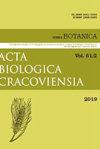GENETIC DIVERSITY AND SPATIAL GENETIC STRUCTURE OF STELLARIA HOLOSTEA POPULATIONS FROM URBAN FOREST ISLANDS
IF 0.5
4区 生物学
Q4 PLANT SCIENCES
引用次数: 9
Abstract
Stellaria holostea is a clonal herb highly confined to well-established deciduous forests. This study examined whether its genetic diversity and spatial genetic organization in urban forest islands is similar to the values from well-established populations outside urban landscape. We studied four populations in Warsaw and two populations from well preserved forests outside the city. Genetic diversity was greater in populations from well-preserved forests than from forests heavily exploited in the past. High clonal diversity indices indicate that the studied populations did not lose the ability to reproduce sexually. The small populations in urban forests differed from the remaining sites in spatial organization. High overall FST (0.24) and the lack of correlation between genetic and geographic distance between the studied populations indicate limited gene flow. Urban forests may be of great value for conservation of S. holostea and other ancient forest species as they may still harbor substantial genetic variability despite their isolation.城市森林海岛全骨星居群的遗传多样性和空间遗传结构
全骨星是一种高度局限于成熟的落叶林中的无性系草本植物。本研究考察了城市森林岛屿的遗传多样性和空间遗传组织是否与城市景观外成熟种群的遗传多样性和空间遗传组织相似。我们研究了华沙的四个种群和城市外保存完好的森林中的两个种群。来自保存完好的森林的种群的遗传多样性比来自过去被严重砍伐的森林的种群的遗传多样性更大。高克隆多样性指数表明研究群体没有丧失有性繁殖能力。城市森林的小种群在空间组织上与其他地点有所不同。总体FST较高(0.24),种群间遗传距离和地理距离缺乏相关性,表明基因流动有限。城市森林可能具有重要的保护价值,因为它们可能仍然存在大量的遗传变异,尽管它们被隔离。
本文章由计算机程序翻译,如有差异,请以英文原文为准。
求助全文
约1分钟内获得全文
求助全文
来源期刊
CiteScore
3.00
自引率
0.00%
发文量
0
审稿时长
>12 weeks
期刊介绍:
ACTA BIOLOGICA CRACOVIENSIA Series Botanica is an English-language journal founded in 1958, devoted to plant anatomy and morphology, cytology, genetics, embryology, tissue culture, physiology, biochemistry, biosystematics, molecular phylogenetics and phylogeography, as well as phytochemistry. It is published twice a year.

 求助内容:
求助内容: 应助结果提醒方式:
应助结果提醒方式:


